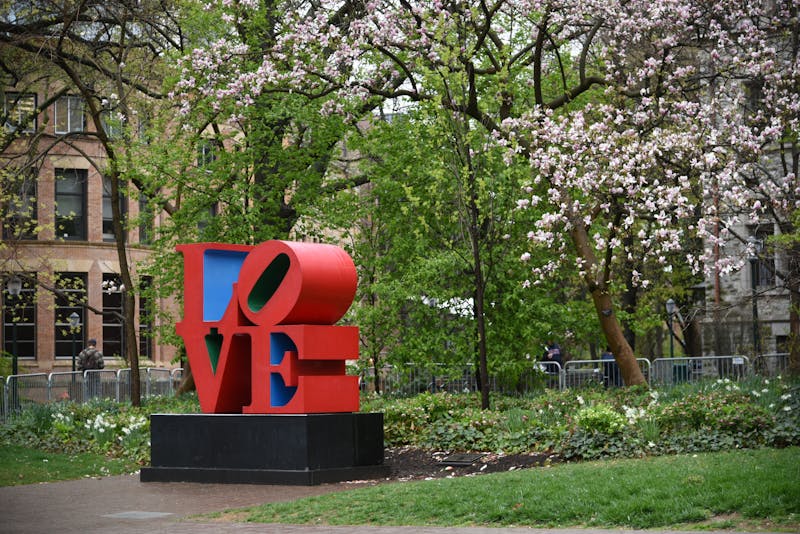There are 14 white posters hanging in the the first floor hallway of Charles Addams Fine Arts Hall. Each poster has a single name printed on it: one for every Penn student who has died by suicide since February 2013. The names were laser cut into the material and are, therefore, so faint that you have to be up close to really see them — that the idea being that those around us require the same attentiveness and care.
It’s a provocative installation, and its message — combatting mental illness requires greater awareness and concern for others — is surely one we can all support. But while the intention of the artist was undoubtedly noble, the sensitivity of the piece itself has been scrutinized. In fact, the intended location for the installation, a more public space outside of the Annenberg School for Communication, was rejected because of concerns that it would be disturbing to some students.
On its face, it’s difficult to understand how the subtle display of those 14 names could be deemed insensitive, especially when it was done with the best of intentions. However, it is important to think critically about the ways in which we respond to tragedy or discuss mental illness, and, for that reason, criticism of the art installation is valuable. Promoting a dialogue on mental health is important, but that doesn’t necessarily mean that all attempts to do so are equally beneficial, or even benign. We should all strive to be conscientious in the ways we respond to mental illness, and to question those approaches that we find troubling.
Adding credence to the concerns of insensitivity surrounding the posters are a series of anonymous messages — presumably written by students — that have been left at the foot of the installation. One message reads, “Elvis was a very good friend of mine. Seeing his name carved out of translucent paper like a ghostly tombstone was extremely upsetting and triggering. Shame on the artist for her insensitivity.”
I’ve never personally known any of the Penn students who have died by suicide. For me, these were not friends, or even acquaintances. They were just fellow students. I felt a connection to their passing, but in an abstract sense. If I’m being honest, I think I focused less on the person and more on what they represented. Every new tragedy seems to be a further confirmation that there is something unhealthy about our culture and our community — that there is something about Penn that exacerbates mental illness.
I still feel that the sheer number of suicides — 14 in four years — speaks to a systemic problem with our campus culture. But that anonymous message left beneath the posters has helped remind me that each situation and each person is unique. Recognizing the greater context in which suicide occurs is important, but we also shouldn’t forget that these were real people with friends and loved ones, not simply symbols of our toxic campus culture.
The real issue at the heart of the anonymous message, as I see it, is the tension between viewing suicide as a symptom of communal rather than personal illness. Clearly the art installation prioritizes the communal perspective — it focuses on our collective failure to take care of one another. But in doing so it also subsumes the individual names, and by extension, their personal struggles, into the larger message. It’s no longer about their illness — it’s about our own.
For the artist who wants to confront Penn’s toxic mental health culture, the inclusion of those 14 names — the apparent victims of that culture — would seem like a justifiable choice. This is what I thought when I first saw the installation. And it’s why I’m glad it’s there. But for that person who now continually walks by and sees the name of their late friend incorporated into someone else’s art project, I imagine it must be painful.
A few feet from that anonymous message is another that reads: “I don’t know these students personally and I don’t feel the need to comment on individual grief but all of us are affected by the scope of this trauma and the issues behind it. We need to properly remember these individuals. Silence is not an option.”
I keep thinking about these conflicting messages and the message of the artwork itself, and all I can say is, I’m torn. Clearly there’s no easy solution, no right way to deal with this trauma or confront these issues. But that shouldn’t deter us from being contentious and thinking critically about how to address those problems. Mental illness is an extremely messy and complex issue. Why should the healing process be any different?
CAMERON DICHTER is a College senior from Philadelphia, studying English. His email address is camd@sas.upenn.edu. “Real Talk” usually appears every other Monday.
CAMPUS RESOURCES
The HELP Line: 215-898-HELP
Counseling and Psychological Services: 215-898-7021 (active 24/7)
Student Health Service: 215-746-3535
Wellness Resources
Office of the Vice Provost for University Life: 215-898-6081
University Chaplain’s Office: 215-898-8456
Reach-A-Peer Helpline
- 215-573-2727 (every day from 9 p.m. to 1 a.m.)
- 215-515-7332 (texting service available 24/7)
Penn Benjamins (in-person peer counseling)
- Su, M, T 8-11 p.m. Harnwell Library First Floor
- W, Tr 8-11 p.m. Houston Hall Chaplains Office
The Daily Pennsylvanian is an independent, student-run newspaper. Please consider making a donation to support the coverage that shapes the University. Your generosity ensures a future of strong journalism at Penn.
Donate








